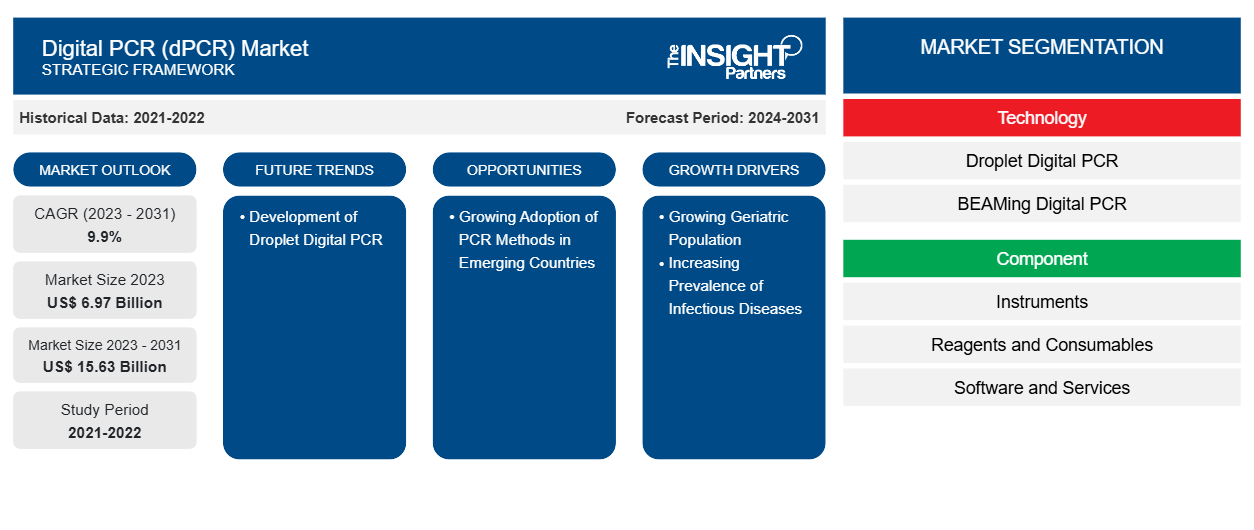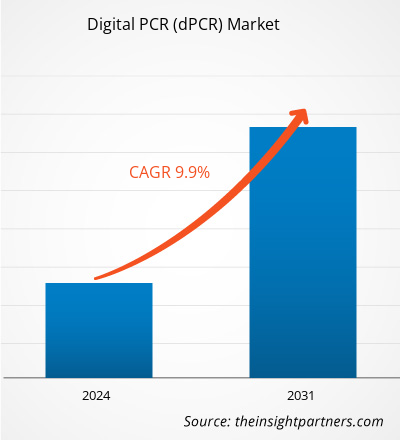The Digital PCR (dPCR) market size is projected to reach US$ 15.63 billion by 2031 from US$ 6.97 billion in 2023; the market is estimated to record a CAGR of 9.9% during 2023–2031.
dPCR is a breakthrough technology that offers ultrasensitive and absolute nucleic acid quantification. It is one of the most accurate, precise, and sensitive techniques for the detection of specific nucleic acid sequences. It has become a crucial and reliable tool for molecular analysis. Increasing incidence of genetic and infectious diseases which can bi diagnosed and treated using dPCR techniques supports the growth of the Digital PCR (dPCR) market. The Digital PCR (dPCR) market trends include technological advancements that aid high-precision and absolute quantification of target DNA molecules, thus enabling a wide range of applications in diagnosis and research.
Growth Drivers:
Gene synthesis is the most accepted tool in the field of recombinant DNA technology. In gene synthesis, recombinant protein expression and dPCR technology are used for amplification as well as quantification purposes. In 2021, Camena Bioscience, a synthetic biology startup that supplies genes to the biotechnology and pharmaceutical industries, completed a US$ 10 million Series A funding round headed by Mercia. With the additional funds, the company plans to expand its operations and power its efforts of developing gSynth, its ground-breaking DNA synthesis platform. The technology platform and other related resources help the company to accelerate the development of gene synthesis.
In 2020, EVONETIX LTD, a synthetic biology startup creating a desktop platform for high-fidelity, rapid, and scalable gene synthesis, announced the completion of its Series B financing round. The company, led by Foresite Capital (a new investor), raised US$ 30 million (£23 million) in this round. Thus, rising investments by companies fuel the gene synthesis market growth, thereby contributing to the Digital PCR (dPCR) market growth.
Customize This Report To Suit Your Requirement
You will get customization on any report - free of charge - including parts of this report, or country-level analysis, Excel Data pack, as well as avail great offers and discounts for start-ups & universities
Digital PCR (dPCR) Market: Strategic Insights

-
Get Top Key Market Trends of this report.This FREE sample will include data analysis, ranging from market trends to estimates and forecasts.
Report Segmentation and Scope:
The Digital PCR (dPCR) market analysis has been carried out by considering the following segments: technology, component, application, end user, and geography. Based on technology, the market is segmented into droplet digital PCR (ddPCR) and BEAMing digital PCR. In terms of component, the market is classified into instruments, reagents and consumables, and software and services. Based on application, the market is categorized into clinical, research, and forensic. The geographic scope of the Digital PCR (dPCR) market report covers North America (US, Canada, and Mexico), Europe (France, Germany, UK, Spain, Italy, and Rest of Europe), Asia Pacific (China, Japan, India, South Korea, Australia, and Rest of Asia Pacific), the Middle East & Africa (Saudi Arabia, South Africa, UAE, and Rest of Middle East & Africa), and South & Central America (Brazil, Argentina, and Rest of South & Central America).
Segmental Analysis:
The Digital PCR (dPCR) market, by product, is categorized into droplet digital PCR (ddPCR) and BEAMing digital PCR. The ddPCR segment held a significant market share in 2023. It is anticipated to record the highest CAGR in the market during 2023–2031.
Based on component, the market is categorized into instruments, reagents and consumables, and software and services indications. The reagents and consumables segment held a significant market share in 2023, and it is estimated to register the highest CAGR during 2023–2031.
Based on application, the market is segmented into clinical, research, and forensic. The clinical segment held a significant Digital PCR (dPCR) market share in 2023; it is expected to register the highest CAGR during 2023–2031.
Based on end user, the market is segmented into hospitals and diagnostic centers, pharmaceutical and biotech companies, research laboratories and academic institutes, forensic laboratories, and clinical research organizations. The hospitals and diagnostic centers segment held a significant Digital PCR (dPCR) market share in 2023; it is expected to register the highest CAGR during 2023–2031.
Regional Analysis:
In terms of geography, the Digital PCR (dPCR) market is segmented into North America, Europe, Asia Pacific, South & Central America, and the Middle East & Africa. In 2023, North America captured a significant share of the market. In 2023, the US dominated the market in this region. The Digital PCR (dPCR) market growth in North America is attributed to scientific conferences, workshops, and events conducted in the US and Canada, which help participants from different parts of the world exchange trends and the latest research outcomes based on PCR. For instance, the Global Information Incorporation’s Global Engage conducted a two-day summit featuring the contribution of worldwide scientists on dPCR strategies and development as well as discuss case studies that involve the contribution of dPCR in healthcare. The active involvement of the country is also one of the driving factors leading to the growth of the region in the global Digital PCR (dPCR) market in the region.
Industry Developments and Future Opportunities:
The Digital PCR (dPCR) market report includes company positioning and concentration to evaluate the performance of competitors in the market. As per company press releases, a few initiatives taken by key players operating in the market are mentioned below:
- In July 2023, Bio-Rad Laboratories, Inc. launched its first ultrasensitive multiplexed dPCR assay—the ddPLEX ESR1 Mutation Detection Kit. With the launch of this product, the company plans to extend the availability of its ddPCR offering for the oncology market, where highly sensitive and multiplexed mutation detection assays aid translational research, therapy selection, and disease monitoring.
- In June 2021, Bio-Rad Laboratories Inc. introduced the “Prevalence ddPCR SARS-CoV-2 Wastewater Quantification Kit,” a sensitive, cost-effective, and accurate instrument for detecting SARS-CoV-2 in the community wastewater.
- The Centers for Disease Control and Prevention (CDC) recommends ddPCR techniques for wastewater testing, and the Environmental Protection Agency (EPA) has published the technology as a reliable way to quantify viruses in wastewater.
The regional trends and factors influencing the Digital PCR (dPCR) Market throughout the forecast period have been thoroughly explained by the analysts at The Insight Partners. This section also discusses Digital PCR (dPCR) Market segments and geography across North America, Europe, Asia Pacific, Middle East and Africa, and South and Central America.
Digital PCR (dPCR) Market Report Scope
| Report Attribute | Details |
|---|---|
| Market size in 2023 | US$ 6.97 Billion |
| Market Size by 2031 | US$ 15.63 Billion |
| Global CAGR (2023 - 2031) | 9.9% |
| Historical Data | 2021-2022 |
| Forecast period | 2024-2031 |
| Segments Covered |
By Technology
|
| Regions and Countries Covered |
North America
|
| Market leaders and key company profiles |
|
Digital PCR (dPCR) Market Players Density: Understanding Its Impact on Business Dynamics
The Digital PCR (dPCR) Market is growing rapidly, driven by increasing end-user demand due to factors such as evolving consumer preferences, technological advancements, and greater awareness of the product's benefits. As demand rises, businesses are expanding their offerings, innovating to meet consumer needs, and capitalizing on emerging trends, which further fuels market growth.

- Get the Digital PCR (dPCR) Market top key players overview
Competitive Landscape and Key Companies:
The Digital PCR (dPCR) market forecast can help stakeholders plan their growth strategies. Thermo Fisher Scientific, Inc.; F. Hoffmann-la Roche Ltd.; QIAGEN; Akara bio, Inc.; Agilent Technologies, Inc.; Biomerieux SA; Abbott Laboratories; Merck KgaA; Promega Corporation; and BD are among the prominent players profiled in the market. These companies focus on introducing new high-tech products, advancements in existing products, and geographic expansions to meet the growing consumer demand worldwide.
Frequently Asked Questions
What are dPCR?
What are the growth estimates for the Digital PCR (dPCR) market till 2031?
Which segment is dominating the Digital PCR (dPCR) market?
What is the driving and restraining factors for the Digital PCR (dPCR) market?
What was the estimated Digital PCR (dPCR) market size in 2023?
Who are the major players in the Digital PCR (dPCR) market?
- Historical Analysis (2 Years), Base Year, Forecast (7 Years) with CAGR
- PEST and SWOT Analysis
- Market Size Value / Volume - Global, Regional, Country
- Industry and Competitive Landscape
- Excel Dataset
Recent Reports
Testimonials
Reason to Buy
- Informed Decision-Making
- Understanding Market Dynamics
- Competitive Analysis
- Identifying Emerging Markets
- Customer Insights
- Market Forecasts
- Risk Mitigation
- Boosting Operational Efficiency
- Strategic Planning
- Investment Justification
- Tracking Industry Innovations
- Aligning with Regulatory Trends





















 Get Free Sample For
Get Free Sample For